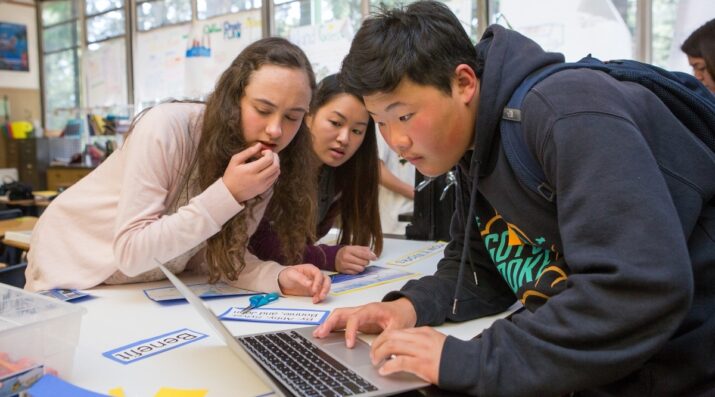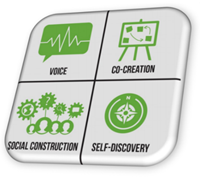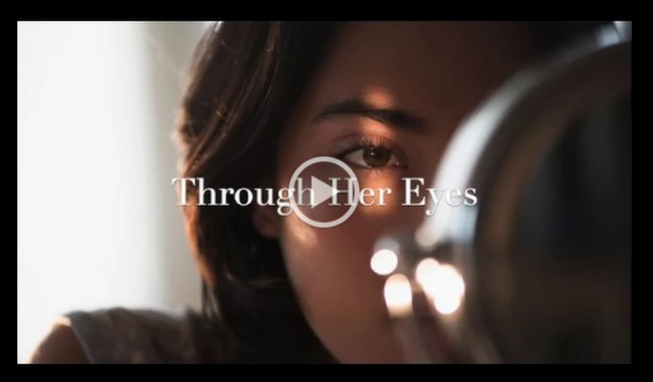New Designs for School
Transforming High School by Engaging Student Autonomy
Topics

We’ve all had the experience of truly purposeful, authentic learning and know how valuable it is. Educators are taking the best of what we know about learning, student support, effective instruction, and interpersonal skill-building to completely reimagine schools so that students experience that kind of purposeful learning all day, every day.
Vista High School students describe an interdisciplinary project that required greater levels of autonomy, voice, and social construction. Student podcasts included!
This post features Vista High School students Kimberly De La Cruz, Abi Blakesly, Lindsey Harris, Mayara Swillens, Julia Calderon, Ivan Robles, and Camden Embrey
The International Center for Educational Research and Practice (iCERP) promotes intersectionality of thought on a global scale. Nothing is more central to this focus than the transformation of the very fabric of education. We are all experiencing a shift in thinking and action around the learning pathways that students are taking; the shift includes moving to a student-centered approach to education, where the students step away from their traditional role as recipients of core subject content and move into the driver’s seat of their quest to become flexible, nimble thinkers and learners in an increasingly complex society.
In this series about Vista High School, we place a laser focus on actively engaging student voice at the high school level in various elements of transformation in education. The goal: to hear, first hand, how these changes are affecting the students’ lives as learners and future members of the global workforce.
This post focuses on using interdisciplinary projects to build greater levels of student autonomy through student voice and social construction of learning activities. Watch this Developing Voice & Social Construction video to meet the students and learn more about their thinking as they assume more autonomy over their learning pathway:
Self-Directed Learners
At Vista High School, we are working to rethink the high school learning experience in order to intentionally develop our students into self-directed learners who understand how to design, manage, monitor, and modify learning opportunities both in and out of the classroom. To accomplish this, we are collaborating with our students to co-create personalized experiences. At Vista High School, we define “personalized learning” in this way:
“Increasingly putting students at the center of the design of learning experiences where they leverage growing strengths, interests, passions, and ideas to engage in authentic problems and challenges that are aligned to standards and students’ personal goals.”
To clarify what this looks like, we subscribe to the “Four Attributes” for growing a personalized learning environment posited by Zmuda, Curtis, and Ulman in their book, Learning Personalized: The Evolution of the Contemporary Classroom (2015). If we are truly engaging students in personalized learning, we should be able to find evidence of Student Voice, Co-creation, Social Construction, and/or Self-discovery as indicators.

Building Student Autonomy
Two of our ninth grade teachers, Kelee Thompson and Stephanie Kiesel, created an interdisciplinary final project that specifically focused on providing students with greater autonomy in the areas of student voice and social construction. The students were required to create a podcast that connected their understanding of human rights to the experiences of any character within the book Of Mice and Men.
Student Kimberly De La Cruz described the basic framework for the project:
“For our final project of the semester, we were instructed to create a podcast and a matching script. Having just finished reading ‘Of Mice and Men’ by John Steinbeck, we were assigned to do our project based off that book. And since we’d been learning so much about the Universal Declaration of Human Rights in our Challenge course, we were asked to focus our efforts on identifying and describing violations that a chosen character had experienced throughout the book and then developing possible solutions to help ensure that the character wouldn’t experience them again.”
Abi Blakesly added:
“It’s an assignment in which we have the freedom to express how we feel about the treatment of a character from the novel. It made us really work hard because we got to choose a character that we feel most passionate about. I loved how we had the freedom to choose and get creative.”
Listen to “Our creation,” the podcast created by Abi’s team about the Of Mice and Men character named Crooks:
Social Construction
In this example, each member of the student team was required to use their voice by sharing their ideas while respectfully listening to the ideas of others in order to socially construct meaning of the novel, its characters, and the personal roles they were to play within their created podcast.
Lindsey Harris described what her team did in this situation:
“We had to figure out the roles each group member would have. The interviewer would be curious, intrigued in learning, questioning, and open. The technician/historian would be good with technology, know their facts about history, and be open to new ideas. The member playing the character would have to be good with accents, funny, and do well with answering open ended questions.”
Mayara Swillens added:
“Everyone contributed ideas and every member of our group had to agree on what we were going to ask and talk about during our podcast.”
Ideas Have Value and Power
We want students to recognize that there is value and power in their own ideas and those of their peers. Providing opportunities for students to develop and add voice to their experiences allows them to express interest in, and connect to, parts of the curriculum. This gives students permission to become advocates for their own learning rather than passively waiting to be told what to do, what to read, and/or what to think.
In this example, student teams used their voice to own their experience by creating a purpose within the project that was relevant to their own lives.
This was made clear when student Julia Calderon identified the character her group chose and why the group made this character the focal point of their investigation:
“My group focused on Curley’s wife. She’s the only girl in the book, and she’s never even given a name. For this reason, we named her ‘Barbara’ because it was very awkward and vague just calling her after her husband. Her rights were violated multiple times throughout the book, for example, being treated like property and not being allowed to do as she wants. It was difficult turning a character into a real life personality because we had to adapt her dialect and think about the way she sees the world. Being the only woman, she’s one of the loneliest people on the ranch. Curley, her husband, treats her like property and he’s very overprotective. Being feminine and pretty, she constantly tries to get the men’s attention in desperate attempts of conversation. Nonetheless, whenever she talks to anyone other than Curley, he gets mad at her.”
Abi Blakesly and her group selected someone different:
“My group chose a character named Crooks who got treated unfairly because of his skin color. He had such unfair treatment all because of what he looked like and my group thought he was the most unfairly treated.”
Kimberly De La Cruz’s group selected yet another character:
“We chose to examine Lennie. Lennie Small was a guy who wasn’t able to think on his own and relied a lot on his travel buddy, George Milton, for directions on what he could and couldn’t do. Because he was treated so differently than others since an early age and had, therefore, grown accustomed to it, he wasn’t able to realize the existence of his rights or that they were always being violated by the people around him. Even his best friend George violated his rights and did so probably more than anyone else did in the book.”
Listen to Kimberly, Lindsey, and Mayara’s podcast, “Small’s World, Big Issues:”
Deeper Thinking
For those who state that personalized learning “waters down” student learning, note that the opportunity for groups to select a character who resonated with them required deep analysis of the character within the story as well as connecting their understanding to the Universal Declaration of Human Rights. Answers to the prompt could not be “Googled” and the deeper thinking required by the students in this opportunity resulted in the reading becoming both more relevant and more personal to the students.
As Julia Calderon related in regards to Curley’s wife:
“Researching characters in the book meant finding human rights that were violated and making sense of them. I take pity on ‘Barbara’ because nobody deserves to be treated as if they're owned by someone else. The first article of the Universal Declaration of Human Rights declares that everyone is born equally and free. That includes men, women, black, white, old, young, rich, poor, everyone.”
Listen to “Through Her Eyes,” the podcast from Julia and her team:
In researching the characters through the lens of human rights, students also built an empathy for these characters often not made when just reading the story. Camden Embry described his insight:
“If we can learn to feel what a person in the great depression felt, especially for a pair of fictional characters we had never heard about until a few weeks ago, we will be able to empathize for all people who we might not initially understand.”
Kimberly De La Cruz described the work of her team member Mayara Swillens:
“Her role in the project required her to embody the exact personality of the actual character during the interview.”
Ivan Robles found his learning experience rewarding as building empathy for the characters deepened his understanding of himself:
“Throughout the project, I found out another reward. That reward is the feeling of empathy. It is hard to believe that a fictional story with fake characters could have such an impact on our real lives. We learn the emotions and stories of these characters and we realize that we have all gone through these feelings and experiences. We realize how much we can relate to what others go through.”
The autonomous nature of this project allowed our students to use their voice to help shape their learning experience. The social construction aspect of the project provided our students the opportunity to explore the book through multiple perspectives, their own inquiries and insights, and connections to their own ideas. In this way, our students made deeper meaning of their learning experience in a more active, thoughtful, and self-directed manner rather than by following the teachers’ instructions to finish a project for a grade.
Read more student perspectives on the learning transformation at Vista High School:
- Creating an environment of wellness
- Challenging students to solve real problems
- Supporting student self-discovery
- Challenging students to take action based on their learning
Top photo courtesy of Allison Shelley/The Verbatim Agency for American Education: Images of Teachers and Students in Action





